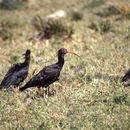Biology
provided by Arkive
The northern bald ibis is a social species foraging in large, loose flocks, mainly for lizards and beetles. These birds feed by pecking at the ground or by probing into cracks and fissures in the earth (9).
Nesting also occurs in colonies, usually of around 40 individuals (5). Nests are made from a loose platform of branches lined with grass and placed on the cliff ledge or cave (9). Egg laying occurs from March to April and a female will lay two to four eggs (10). Northern bald ibis are relatively long-lived, with an average life-span of 24 years (10).
Conservation
provided by Arkive
BirdLife International and the Royal Society for the Protection of Birds (RSPB) have been working alongside local people to research and monitor this enigmatic species. A major step has been to train and manage a team of wardens in Morocco to monitor breeding and roosting sites, prevent disturbance by tourists or fishermen, collect information, and make local people aware of the bird's significance; these conservation measures have resulted in a recent slight population increase (1) (7). The recently discovered Syrian population is also being carefully monitored (7).
In the semi-wild Turkish population, the birds are recaptured and kept during the winter in large aviaries, but are freed during spring-summer to breed in the traditional breeding colonies (8). The importance of the bald ibis here is well known; the species is the main symbol of Birecik, and ibis imagery appears everywhere there - from the logo of the local council to the names of companies and restaurants (8). When the northern bald ibis population at Birecik declined to just 41 birds by late 2001, the RSPB and Doga Dernegi (BirdLife Turkey) became actively involved with the Turkish authorities and started to implement a local project, which has had huge success (8). An aviary management and husbandry manual has been produced, and technical advice provided throughout, so that aviaries have been better managed, and the population now reaches almost 100 birds (8). A small interpretation centre at the bald ibis station has been established, where some educational activities are carried out, and a tourism plans are currently being developed for the area based on the image of the bird, which would help raise awareness of the bird's importance and help create funds for its ongoing conservation (8).
However, despite these conservation initiatives and successes, the future of the bald ibis is far from secure, and constant vigilance will be needed if this bird, once revered by the ancient Egyptians, is to remain in even this fraction of its former range (10).
Description
provided by Arkive
The northern bald ibis has undergone a long-term decline over the centuries and is today Critically Endangered (5). Adults have a bare head and neck, which are red in colour apart from a black crown (2). Blueish-purple feathers cover the rest of the body and are long and glossy with a metallic green hue (2). The upper wing-coverts are a glossy purple-red and the long curved beak is also red (2). Juveniles have a dark (although not glossy) appearance and have grey feathers on their heads (2).
Habitat
provided by Arkive
The birds feed in semi-arid steppe areas and breed on coastal cliffs (6).
Range
provided by Arkive
Historically found throughout central Europe, North Africa and the Middle East (9). The bald ibis was thought to be confined to Morocco at the Souss-Massa National Park and at nearby Tamri (5), until an additional small colony was rediscovered in central Syria in 2002 (7). A semi-wild population also exists in Birecik, southeast Turkey, close to the Syrian border (8).
Status
provided by Arkive
Classified as Critically Endangered (CR) on the IUCN Red List 2007 (1). Listed on Appendix I of CITES (3) and Appendices I and II of the Convention on Migratory Species (CMS or Bonn Convention) (4).
Threats
provided by Arkive
The reasons for the long-term decline of this species are poorly understood and may in part be due to natural causes (5). The recent precipitous decline however, is almost undoubtedly linked to hunting and persecution, disturbance at the breeding sites, and the loss of suitable habitat, such as steppe and unintensive arable land and flooding of foraging areas due to construction of dams and drainage of wetlands (5) (8). Pesticide poisoning has also had disastrous consequences, most notably in Turkey in the late 1950s, when hundreds were killed outright by DDT (sprayed to kill mosquitoes), with the survivors subsequently suffering very low breeding success (8) (9). In May 1996, 40 of the Moroccan birds died in just nine days due to an epidemic of unknown cause, demonstrating how vulnerable the small, remnant populations are (8).

